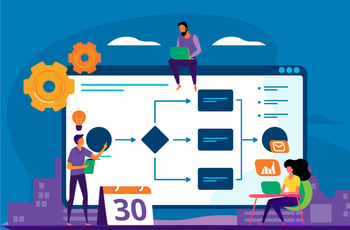by Jim Render, Regional Sales Manager, Q2 Sydney Office
Saying the past few months have been interesting for mortgage lenders is an understatement. Mortgage refinancing has become an attractive option for homeowners as some central banks have lowered their base rate in response to the fallout from the COVID-19 pandemic. On the flip side, lenders have found themselves responding to a need for mortgage holidays (i.e., pausing monthly mortgage repayments) to help customers unable to meet their payments due to sudden financial hardship. The same banks will have to start the heavy lifting on collections soon enough, all the while anticipating further volatility related to the unpredictable nature of COVID-19.
Perhaps more significantly, lenders have had to deal with this unprecedented, and often complex, demand remotely. Many have discovered they don’t have the systems or processes in place to manage it. The solution—digital mortgage lending—already is available to financial institutions (FIs), but it has represented an infinitesimally tiny portion of the market. For the larger lenders, their digital mortgage offering typically has stretched only to advertising attractive rates online and via mobile banking, hoping for a digital-first contact. The rest of the job would be carried out in-person.
The digital demographic is ready to buy
Now more than ever, customers expect seamless digital experiences for ever-expanding reasons. Visits to brick-and-mortar branches, already on a downward slope, may never recover. Research shows that digital lending (that is, lending that assesses customers using primarily automated and algorithmic technology) is less discriminatory toward single women and minorities, groups that hold an increasingly larger share of the market. Consequently, digital lending can help growth and fair lending compliance efforts alike.
Millennials and Gen Z are ready to buy, and they want to buy online. While there’s no market-wide, hard data on digital mortgages at the moment, fintech startup Athena Home Loans received $250 million in digital mortgage applications during the first three days after its launch—all on a platform built by Q2. The fully automated end-to-end digital Athena solution is the kind of solution customers expect now, whether they’re buying groceries or mortgages online. It’s 100% transparent and designed exclusively for them.
Mortgage lenders will all need to get on board with digital—and in the fullest sense. Having a digital veneer will not be enough, nor will offering a digital system only designed to deal with volume.
The benefit of a fully digital process far surpasses the ability to operate remotely. As a general rule, digital systems leverage more data from a wider range of sources, which can give FIs a more complete view of a customer’s finances. Personal finances can be dynamic, particularly during and in the aftermath of a pandemic. Traditional measuring sticks, such as simple credit ratings, no longer provide the full array of information FIs need.
Digital: last year’s leap is now common sense
Because of their ability to use and process more data, best-in-class systems also calculate the risk borne by both parties with a greater degree of accuracy, and so while customers get a more personalised product, lenders also make a good deal. This has an effect even at the top level—FIs can fine-tune their loan loss reserves.
Digital lending systems provide more information to relationship managers too and help them do what they do best—advise. Instead of providing the FI and the customer minimal information, digital solutions provide more intelligence on amortisation, term, loan-to-value ratio, and collateral—in both current and forecasted markets. The information provided can be altered and tailored to a range of life scenarios expected and suggested by the customer or relationship manager. The Athena Home Loans platform built by Q2 was praised by the fintech for being “highly configurable”, providing more security, and featuring the kind of integrations like Salesforce that support volume seamlessly while enhancing the customer experience. This sort of lending experience—for FI and customer alike—will become the benchmark.
Open Banking removes roadblocks
Digital mortgage lending will likely grow at pace. Customers are becoming used to seamless and personalised digital experiences in the rest of their lives, and FIs will regret avoiding the transition for much longer. E-signing may seem like a big adjustment to make if you’re on the inside, but to customers, it just makes common sense. Fortunately, regulators are in support. As of July 1, Australian customers can grant accredited third parties access to their banking data. This will make switching banking products much easier for financial consumers, including choosing a new mortgage provider. Assessment will no longer be a lengthy process. The advent of open banking has removed a big roadblock to rolling out digital mortgages.
Mortgage lending driven by digital, automated, intelligent technology will be a game-changer for both customer and lender. The customer will benefit from a mortgage solution that is more likely to fit their finances (crucial in volatile times), and the lender will be able to advise better, retain their customer base as a result, and stay on the right side of regulators and consumer protection bodies. It’s time to get on board; if you have a digital option, chances are it will grow itself.





